Sun-soaked or shady, windy or still, a balcony can host an entire micro-garden when you choose compact, container-friendly flowering plants. The twenty selections below were picked for nonstop color, modest root systems, and reliable performance in pots, railing boxes, or hanging baskets. Together they cover every exposure—from scorching summer ledges to cool, north-facing corners—and bring bonuses such as fragrance, edible petals, pollinator appeal, and easy seed-saving. Wherever you live, mix two or three with trailing foliage or herbs and you will have a living tapestry that thrives on limited soil and your daily five-minute care routine. Ready to turn a bare ledge into a bloom-filled retreat? Read on for plant-by-plant inspiration.
1. Sun-Loving Petunia Balcony Blossoms
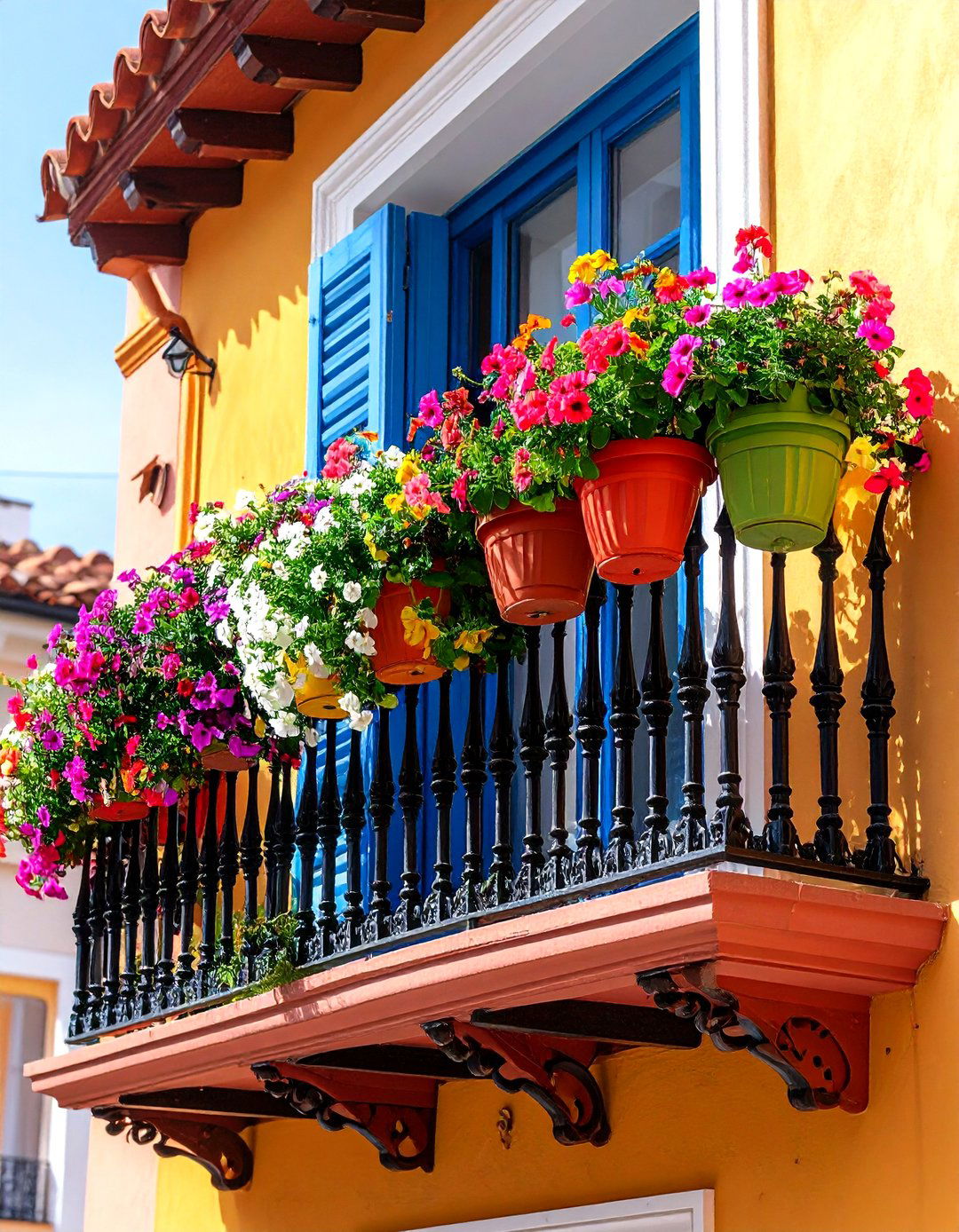
A burst of carnival color is exactly what a balcony needs, and petunia is the straightforward flowering plant to deliver it. Modern hybrids bred for containers keep themselves tidy, dropping spent petals so you can skip deadheading. Give each pot at least six hours of direct light, water when the top inch dries, and top-dress with slow-release fertilizer to keep the show running from March to the first hard frost. Light mid-season trimming—never removing more than a quarter of the plant—encourages fresh branching and denser bloom carpets. Even a single 30 cm pot can trail over a meter, transforming a railing into a floral waterfall.
2. Hardy Geranium Pelargonium Balcony Standouts
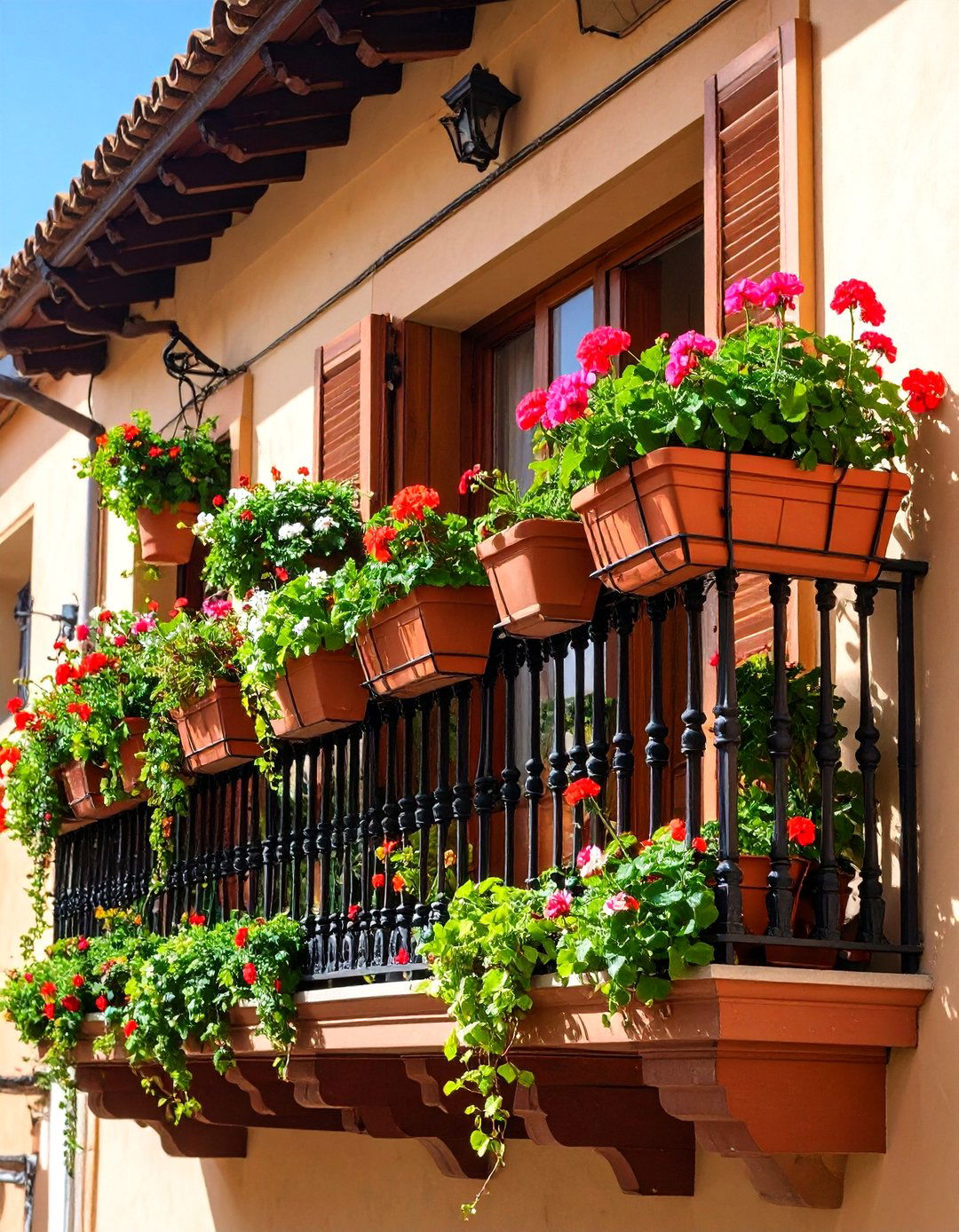
For balconies blasted by sun and occasional neglect, zonal geraniums (Pelargonium) are nearly indestructible. Their fleshy stems store water, allowing them to forgive a missed watering, while their ball-shaped clusters pump out reds, pinks, and bi-colors that stay vivid even in bright glare. Use a nutrient-rich potting mix with pH around 6.0 for the most prolific bloom, and pinch faded heads weekly to keep fresh buds coming. If wind is a problem, choose the compact “ivy” types that drape gracefully without snapping. Come winter, cut stems by half and overwinter indoors on a sunny sill to restart the display next spring.
3. Shade-Brightening Begonia Balcony Color
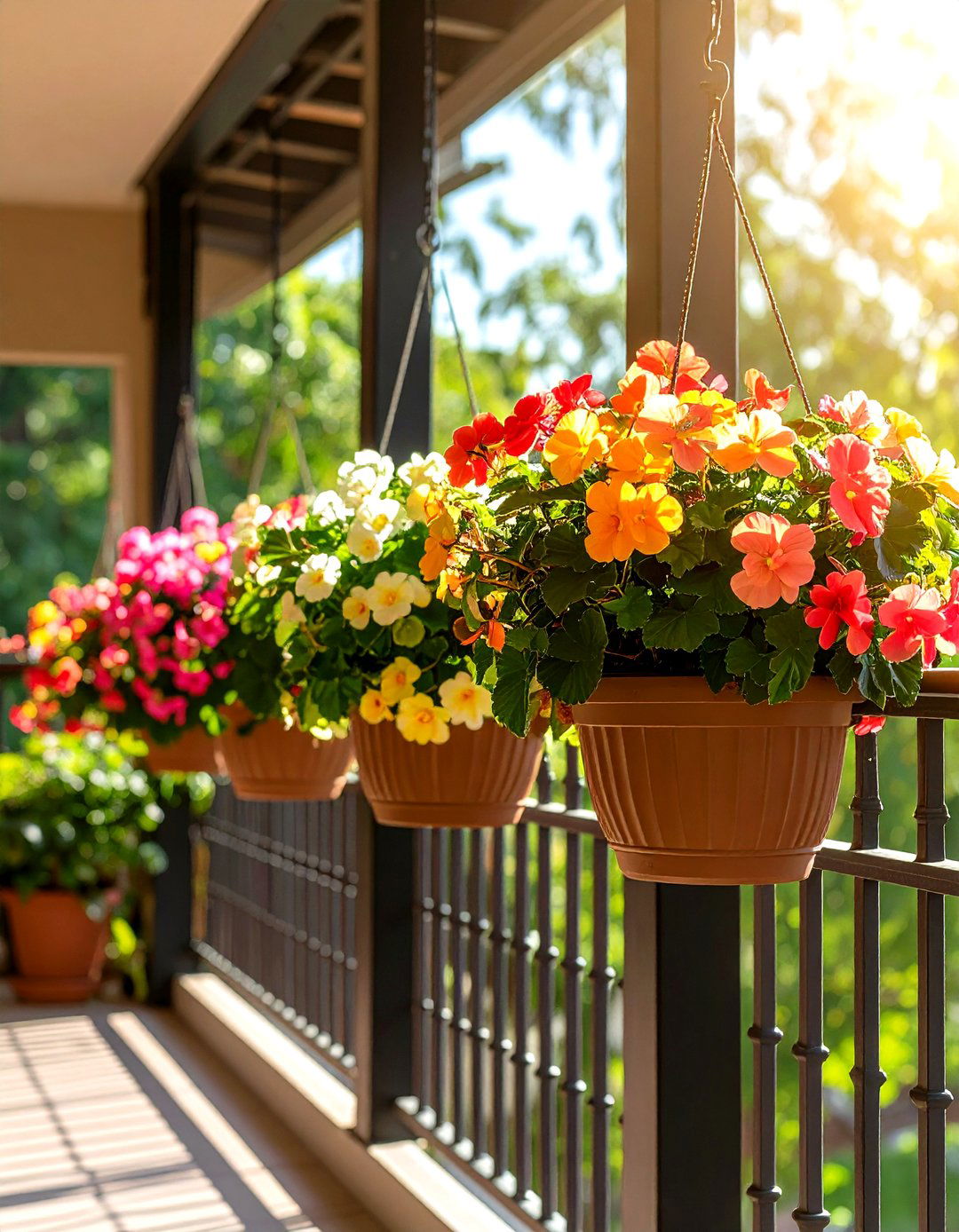
Unlike many flowering balcony plants, wax and tuberous begonias thrive where sun is scarce, turning gloomy corners into jewel boxes of ruby, coral, or snow-white blooms. Their glossy leaves conserve moisture, so water only when the surface feels dry; too much leads to root rot. In deep shade, choose luminous varieties with pink or white flowers to catch limited light. A monthly shot of balanced liquid fertilizer keeps foliage lush, but skip heavy feeding to avoid leggy growth. Because begonias are self-cleaning, a quick finger-snip of the occasional spent cluster is all the grooming required for a season-long glow.
4. Cheerful Marigold Balcony Baskets
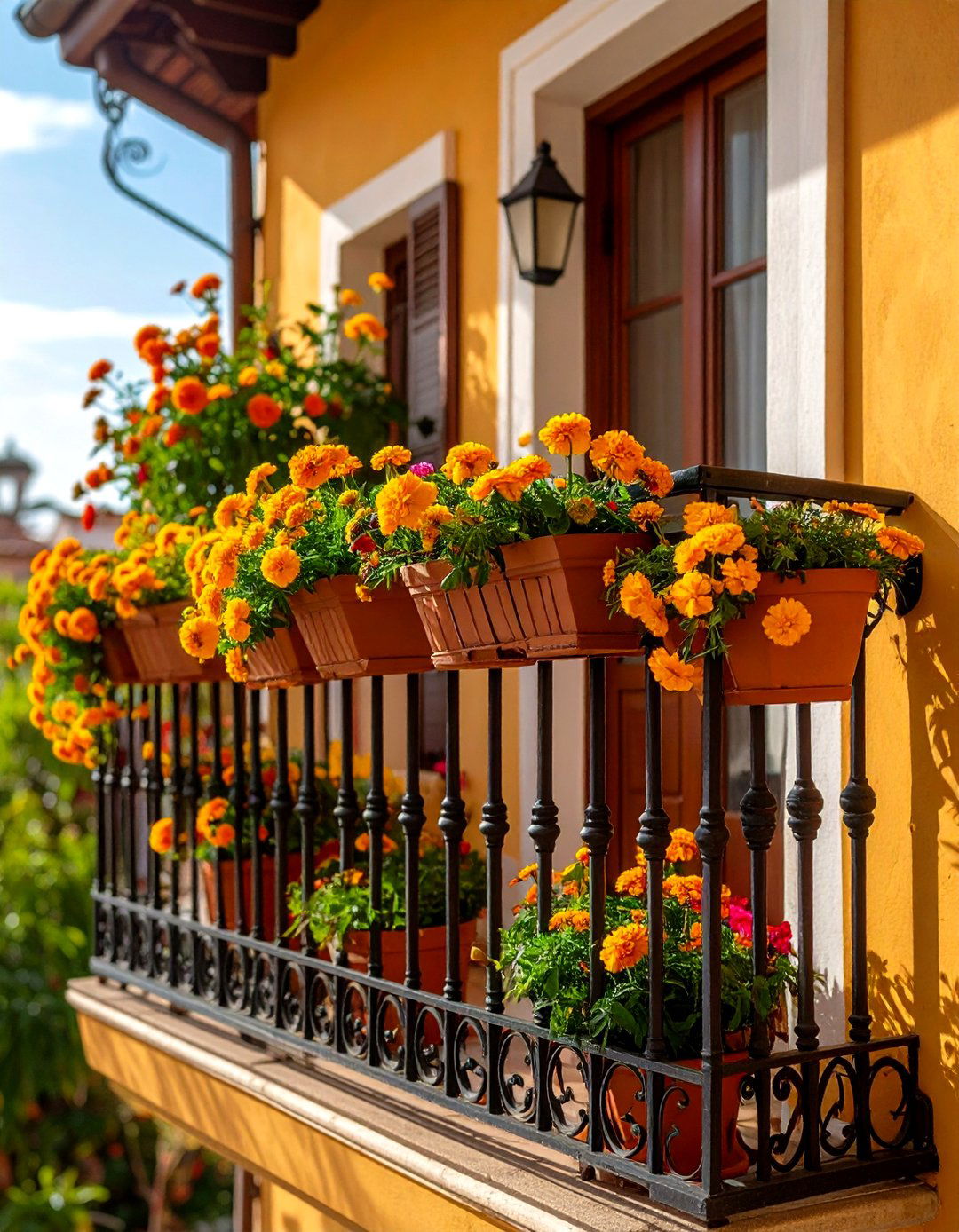
Bright marigolds bring the scent of summer fields to even the smallest ledge. Dwarf French and African types reach 20–30 cm, filling pots with ruffled gold and copper pom-poms that shrug off heat and repel pests. Let the top few centimeters of soil dry before watering, then soak thoroughly to encourage deep roots that can handle high-rise breezes. Deadhead weekly to extend the bloom show, and save the final seed heads for next year’s sowing—marigolds germinate readily, making them a budget-friendly staple. Their earthy aroma also helps mask city odors, earning them double duty as visual and olfactory balcony boosters.
5. Cascading Fuchsia Balcony Drama
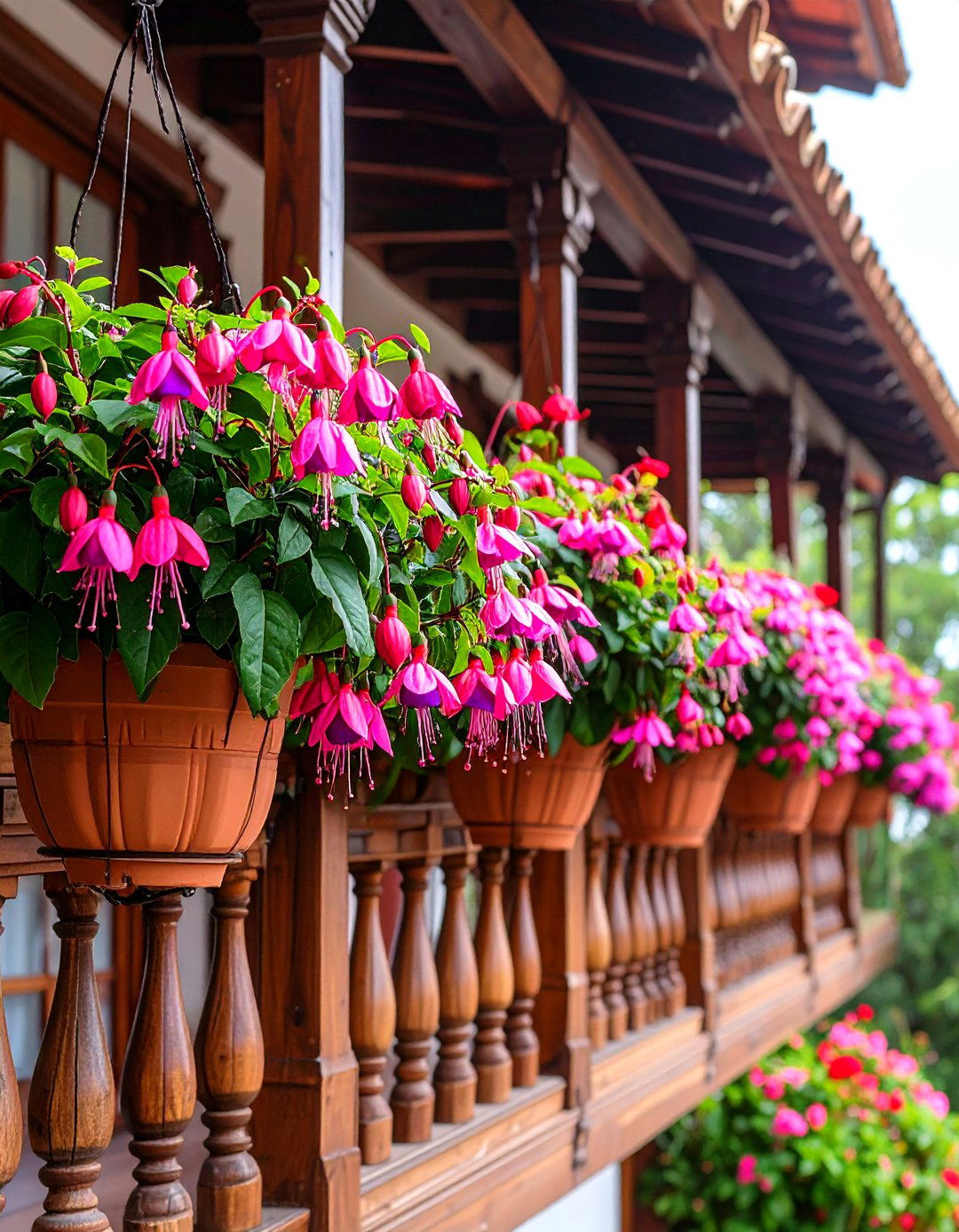
Dangling, two-tone fuchsia blooms look like miniature lanterns swaying in the wind, perfect for hanging baskets at eye level. Most varieties prefer morning sun and afternoon shade; in hotter regions, give them dappled cover during midday to prevent bud drop. Maintain constant but not soggy moisture, and feed every two weeks with a high-potassium fertilizer to keep flowers coming. Pinch back early growth to encourage branching, and you’ll be rewarded with dozens of stems draped in pink-and-purple or red-and-white skirts. Their nectar-rich flowers also draw hummingbirds where they occur, adding a touch of wildlife theater to your balcony stage.
6. Reliable Impatiens Balcony Shade Flowers
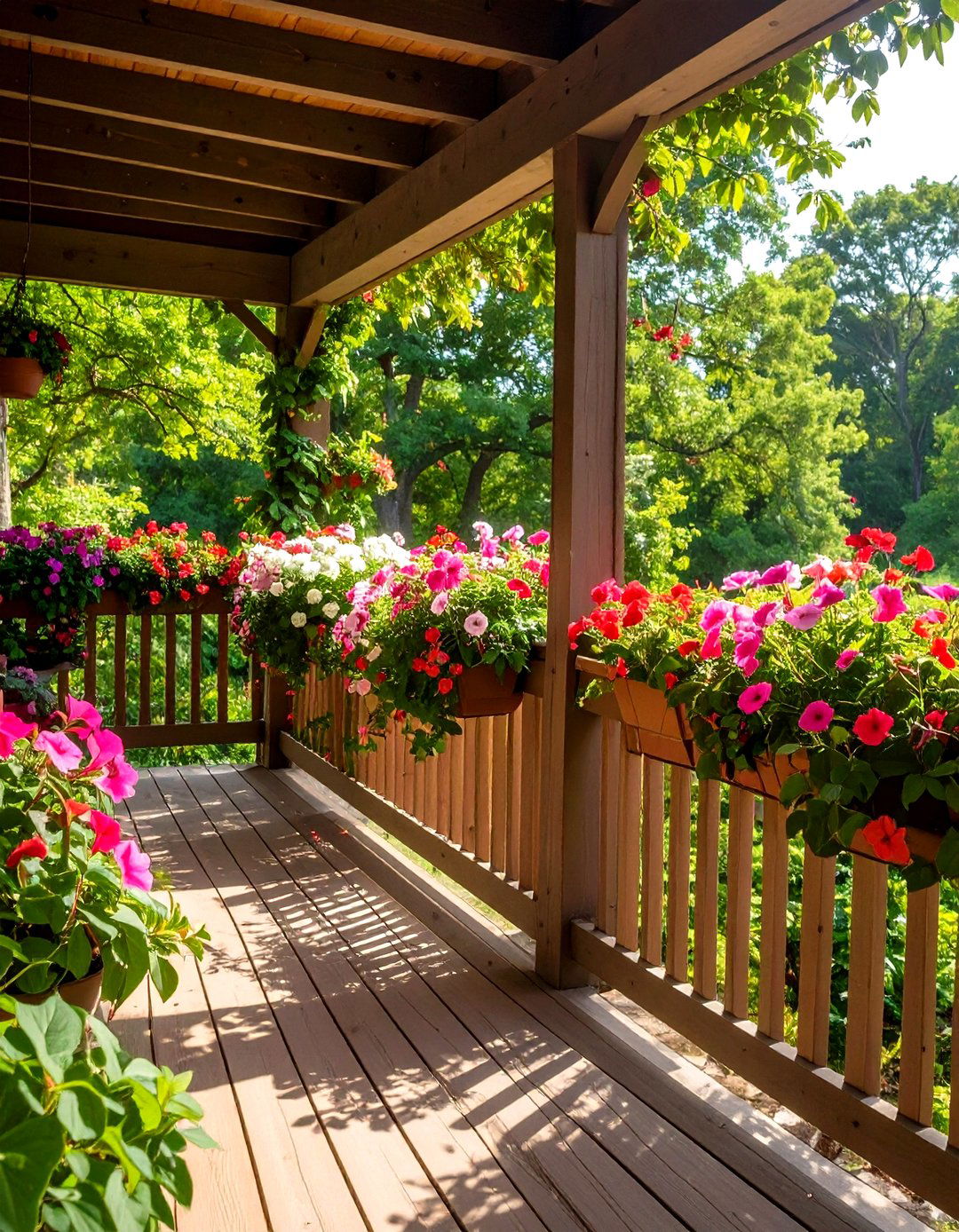
When your balcony receives less than three hours of direct light, impatiens—aptly nicknamed “Busy Lizzies”—step up with unbroken bloom. Choose disease-resistant modern hybrids for containers, plant them in moisture-retentive mix, and water consistently; drying out can stall flowering. New Guinea types tolerate brighter conditions and boast larger petals, while classic bedding strains excel in dense shade. Pinching off the first bud cluster encourages a bushier plant, but thereafter impatiens self-clean, freeing you for hammock time. Their wide color palette—from soft apricots to electric magentas—makes them ideal partners for foliage plants such as ferns or coleus in mixed balcony tubs.
7. Trailing Verbena Balcony Spillover
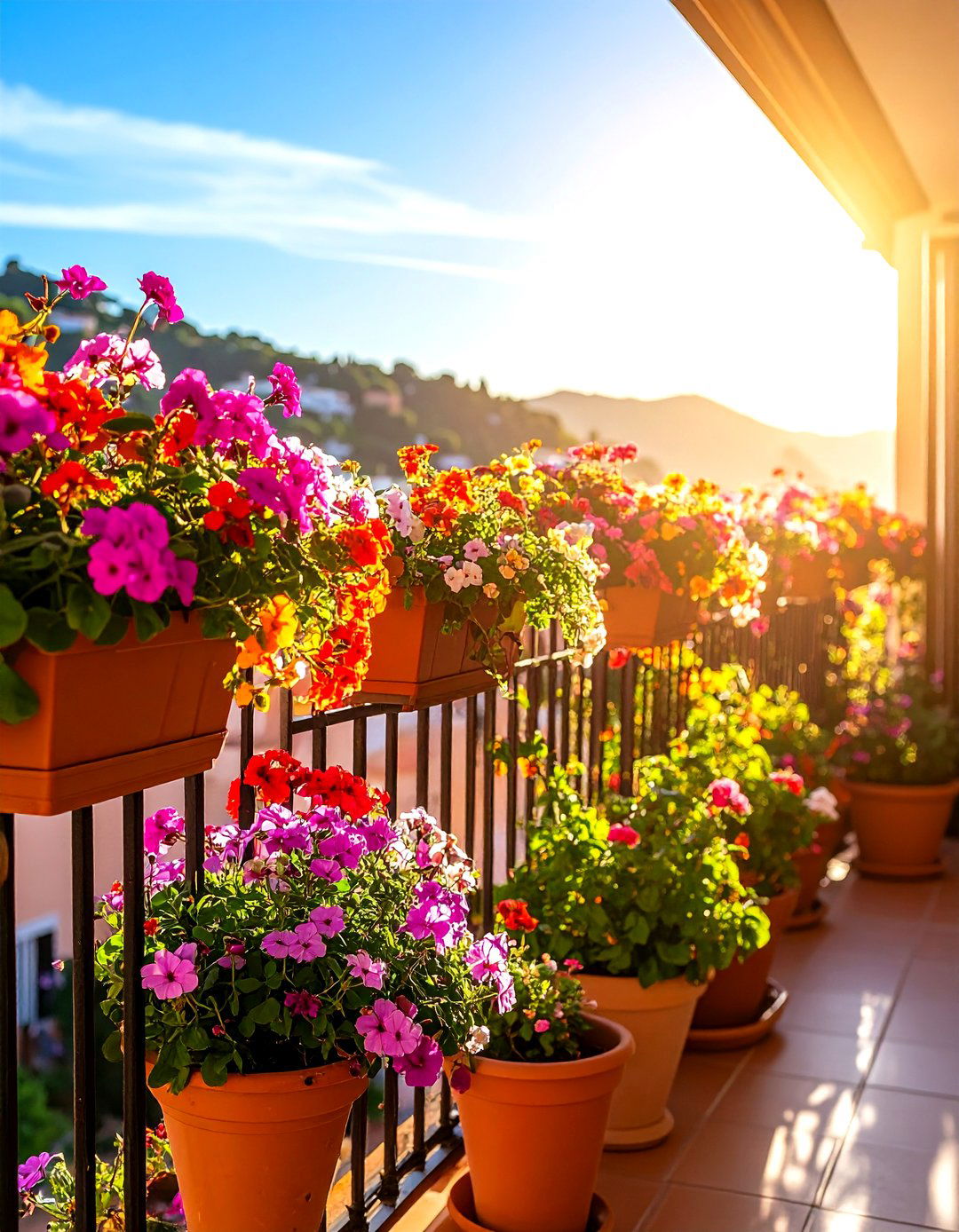
With clusters of tiny trumpets in every pastel and neon hue, verbena delivers continuous color that cascades over pot rims. Six to eight hours of direct sun produce the heaviest bloom; in searing climates, provide light shade after lunch to prevent leaf scorch. Allow the top layer of soil to dry, then water deeply—verbena dislikes constantly wet feet. Mid-summer, shear plants by one-third to trigger a fresh flush of buds right through autumn. Their butterfly-magnet nectar and faint fragrance make evening balcony lounging twice as pleasant, and mildew-resistant selections stay clean even in humid coastal air.
8. Cool-Season Pansy Balcony Charm

Pansies thrive in shoulder seasons when heat-lovers sulk, smiling from early spring until temperatures climb above 27 °C and again from late autumn. Plant them in well-draining pots, keep soil evenly moist, and feed lightly every three weeks. Their “faces” come in velvety purples, sunny yellows, and bi-color whiskered patterns that lift grey mornings. To rejuvenate leggy stems after warm spells, pinch back by half and shift the container into partial shade. Because pansy petals are edible, you can snip a few to decorate balcony brunch plates, adding both beauty and a subtle wintergreen flavor.
9. Edible Nasturtium Balcony Blooms

Spicy-sweet nasturtium is the multitasker of balcony gardening: a flowering plant, a salad garnish, and a natural pest decoy all in one. Compact mounding varieties fill pots; trailing types spill three feet, perfect for railing planters. Sow seeds directly—nasturtium resents transplanting—and water sparingly, as rich soil and heavy feeding reduce bloom in favor of leaves. Every part is edible, so scatter petals over pasta or pickle the peppery seedpods as “poor-man’s capers.” Their bright oranges and yellows also lure aphids away from nearby herbs, providing living balcony pest control without chemicals.
10. Versatile Calendula Balcony Glow
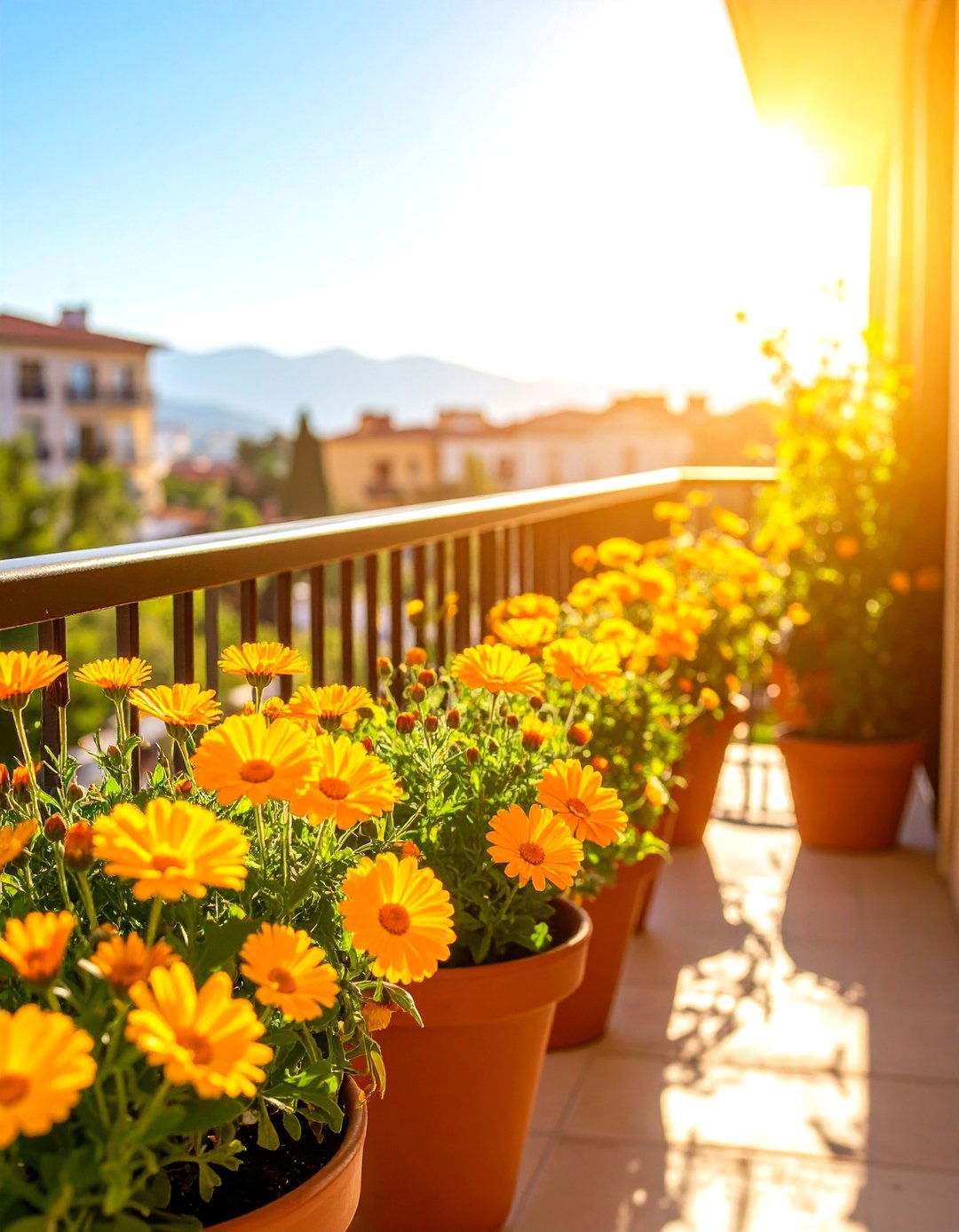
Often called pot marigold, calendula gifts sunny daisy-like flowers that keep coming in cool weather and self-seed politely if a few heads are left to dry. It prefers full sun but appreciates afternoon shade where summers scorch, and needs only moderate watering. Deadhead to prolong bloom, or harvest petals for soothing balms and culinary color. Calendula’s sticky stems trap aphids, making it a helpful companion around balcony vegetables. Compact cultivars reach just 30–45 cm, fitting neatly into railing boxes or mixed tubs without overshadowing neighbors.
11. Fragrant Dianthus Balcony Clusters
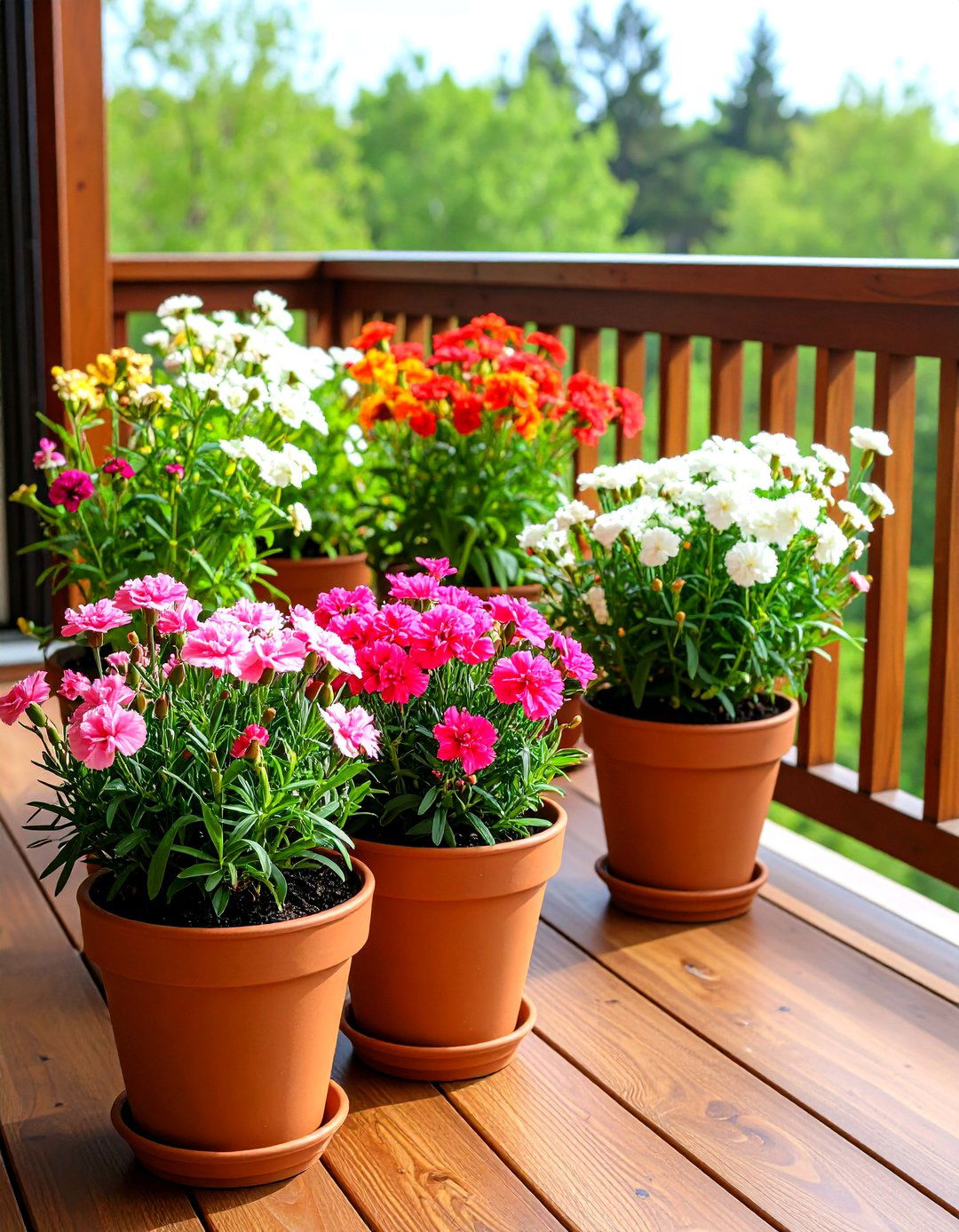
Sweet William and other dianthus cousins release a clove-spice perfume that perfumes evening air on small balconies. Plant in full sun, though a touch of afternoon shade in hot zones lengthens blossom life. Good drainage is critical; use a gritty mix and lift pots on feet so water never pools. Shear off entire spent clusters to coax new flushes, and you’ll enjoy two or three bloom waves before winter. Compact forms stay under 25 cm, making them ideal edging around taller container companions while feeding visiting bees with their rich nectar.
12. Drought-Smart Portulaca Balcony Rug
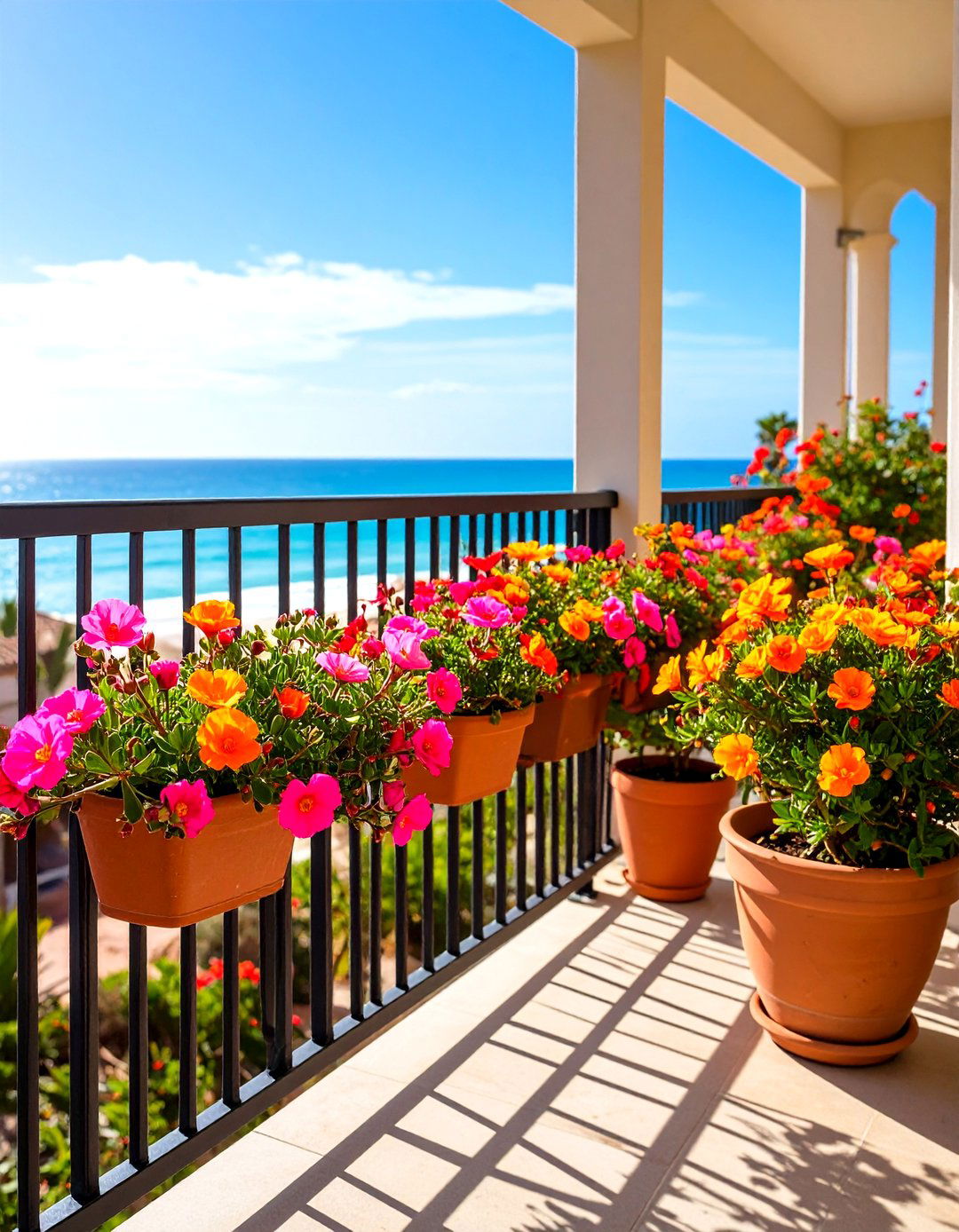
If you forget to water, portulaca—nicknamed moss rose—won’t complain. Succulent leaves store moisture, and blooms only open fully in bright sun, so find your hottest ledge and watch a carpet of neon pinks, oranges, and yellows unfurl daily. Though self-cleaning, a light deadhead every fortnight can extend flowering into fall and curb self-seeding. Provide sandy potting mix and skip fertilizer; too much richness reduces bloom. Combine with upright grasses or dwarf palms for a desert-chic balcony vibe that thrives on neglect.
13. Vivid Zinnia Balcony Zest
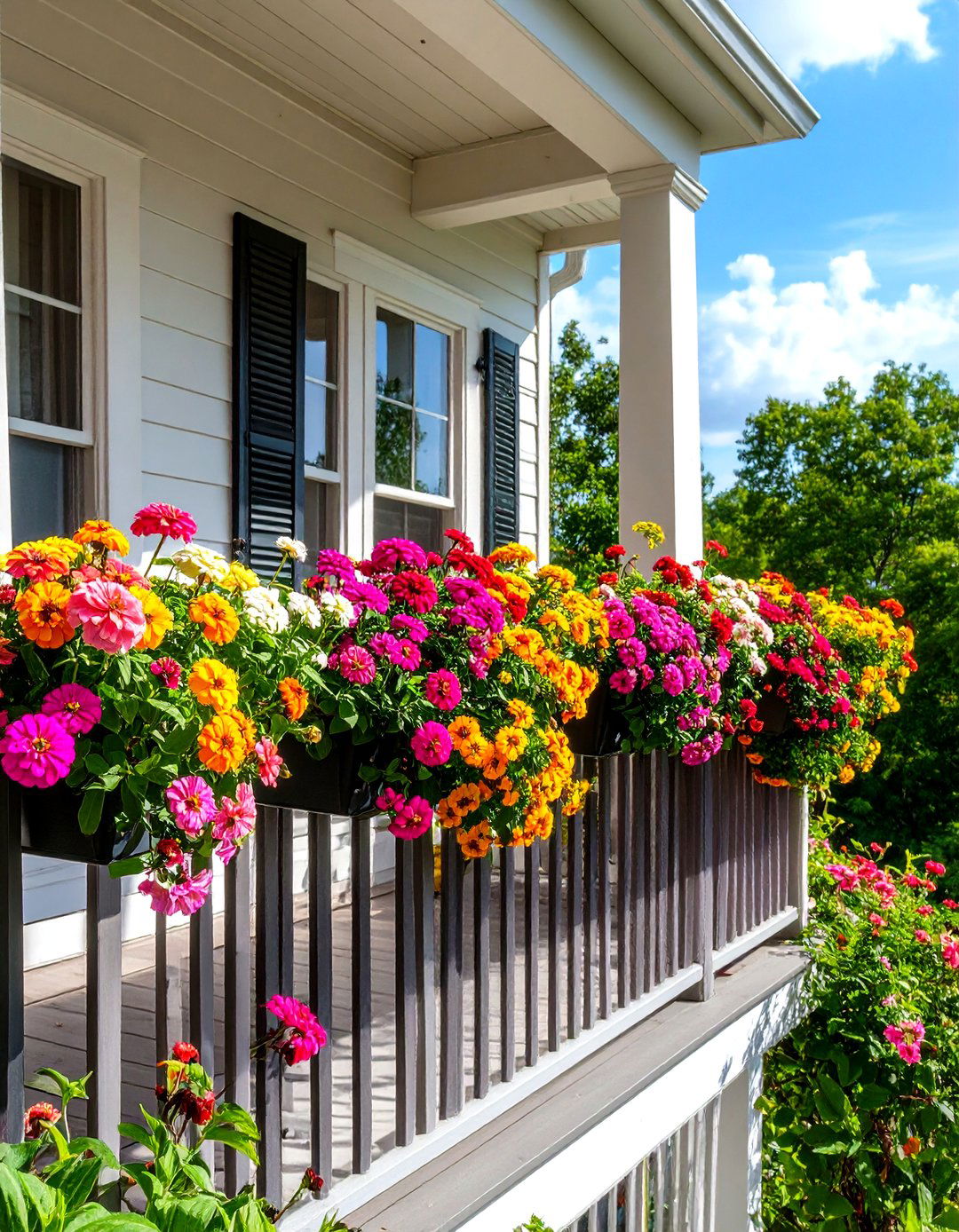
When you crave big, bold color on waist-high railing boxes, zinnias deliver with minimal fuss. Dwarf series stay below 35 cm yet pack huge, chrysanthemum-style blooms in every shade from lime to scarlet. Full sun and weekly deep watering are the keys; overhead splash is fine because modern hybrids resist mildew. Remove old flowers right at the stem junction to spark fresh buds, and harvest a few long-lasting stems for indoor jars—cutting actually increases production. Zinnias attract butterflies, so expect winged visitors swirling around your urban perch from midsummer onward.
14. Compact Snapdragon Balcony Spires
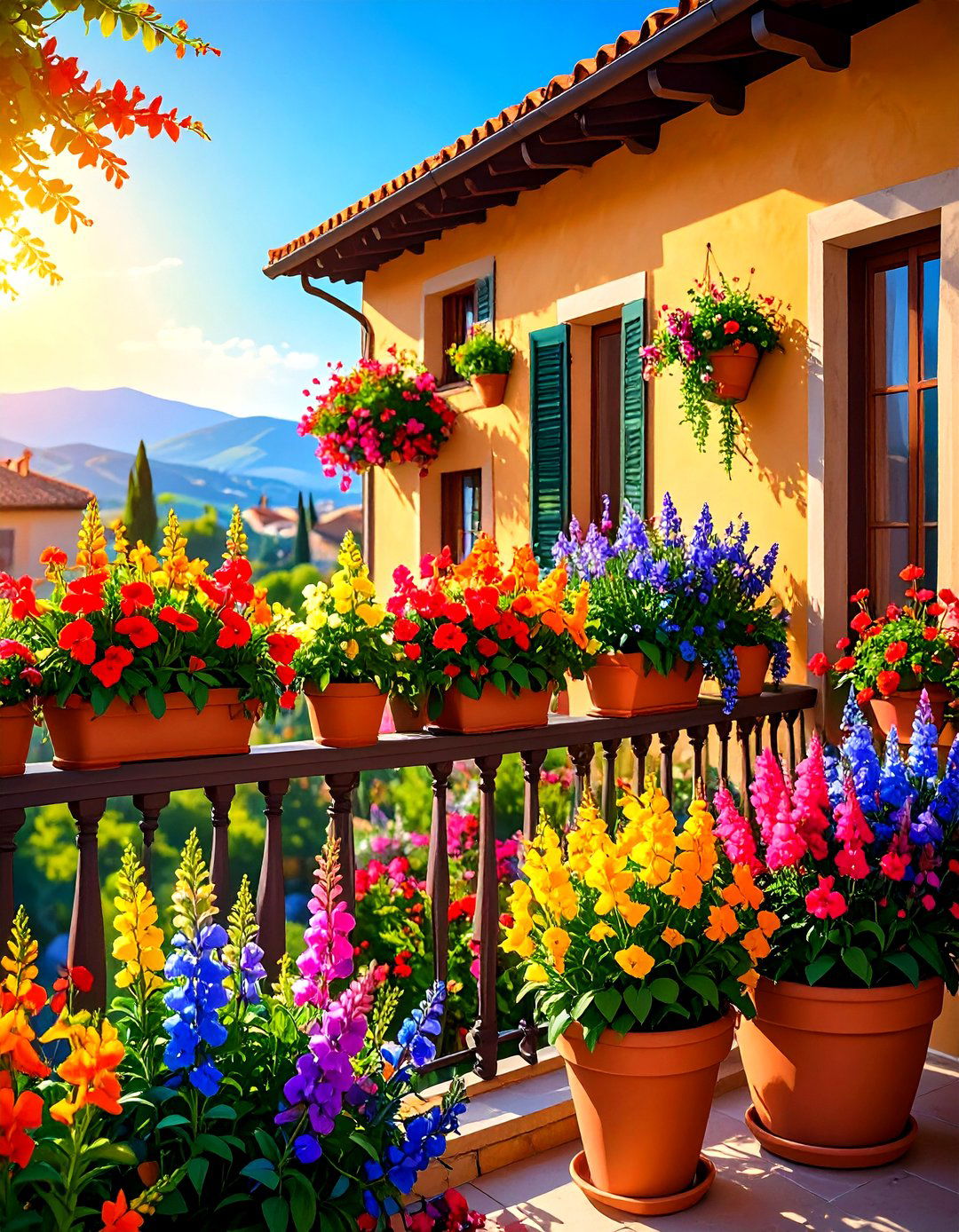
Snapdragons bring vertical interest to shallow boxes where space is at a premium. Choose dwarf or “Montego” strains reaching 20–25 cm, and tuck them into rich, well-drained soil. Water when the surface dries, then allow brief drying intervals; constantly wet mix leads to root issues. Pinch young plants to encourage branching, and deadhead promptly so stems keep stacking buds. Their whimsical, squeeze-open flowers come in sunset shades that glow during cool spring and autumn weather, and make delightful child-friendly balcony bouquets.
15. Dwarf Bougainvillea Balcony Bracts
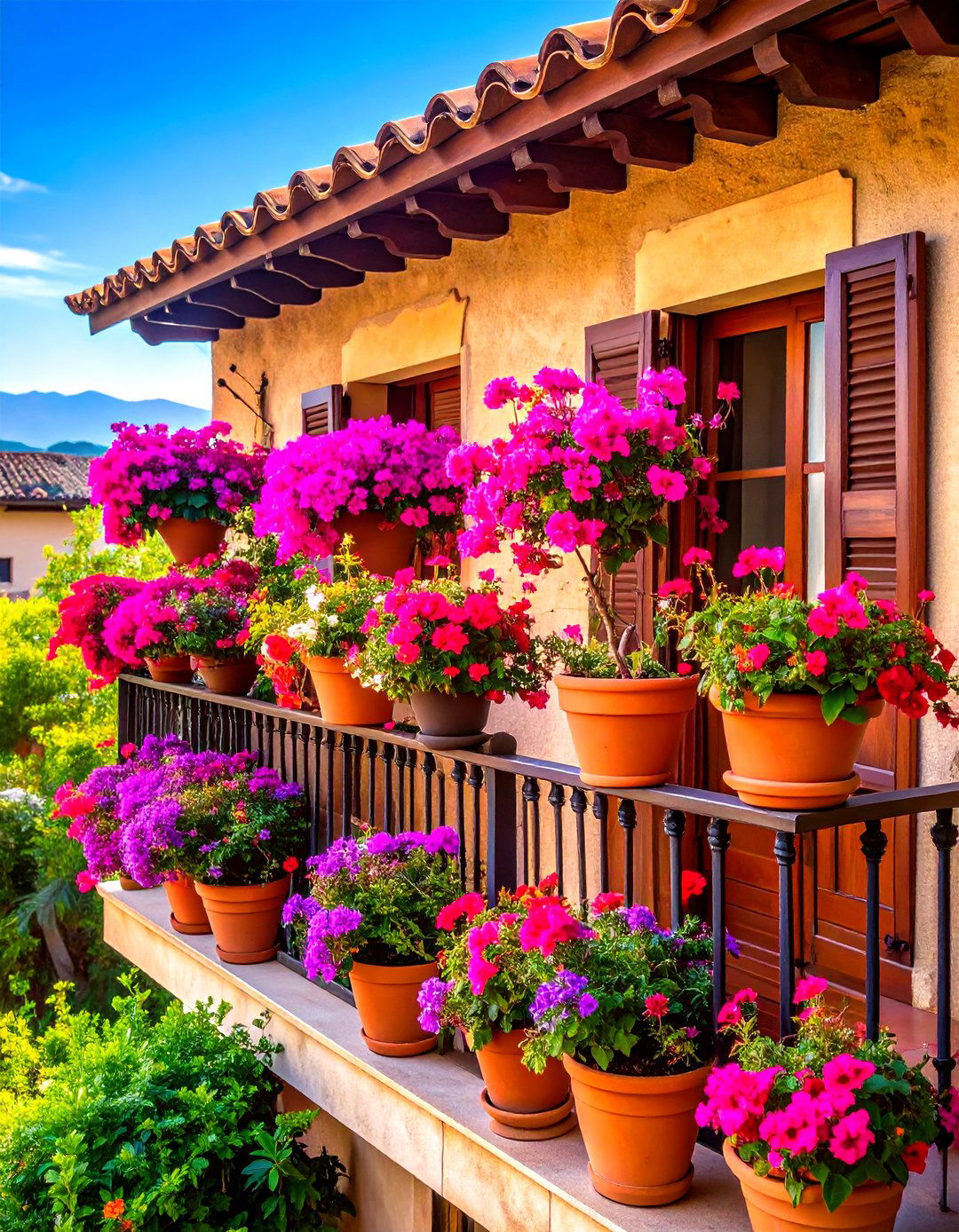
For a Mediterranean splash in tight quarters, dwarf bougainvillea varieties burst with papery bracts in magenta, orange, or snowy white while staying under one meter tall. Full sun is essential; fewer than six hours reduces bloom. Use a terracotta pot with gritty mix for drainage, and let soil dry slightly between soakings. Feed monthly with a bloom-boost formula, and prune lightly after each flush to maintain shape. In cooler climates, wheel the pot indoors before frost—cut back by a third to fit through doors, then place near a bright window until spring warmth returns.
16. Patio Hibiscus Balcony Tropics
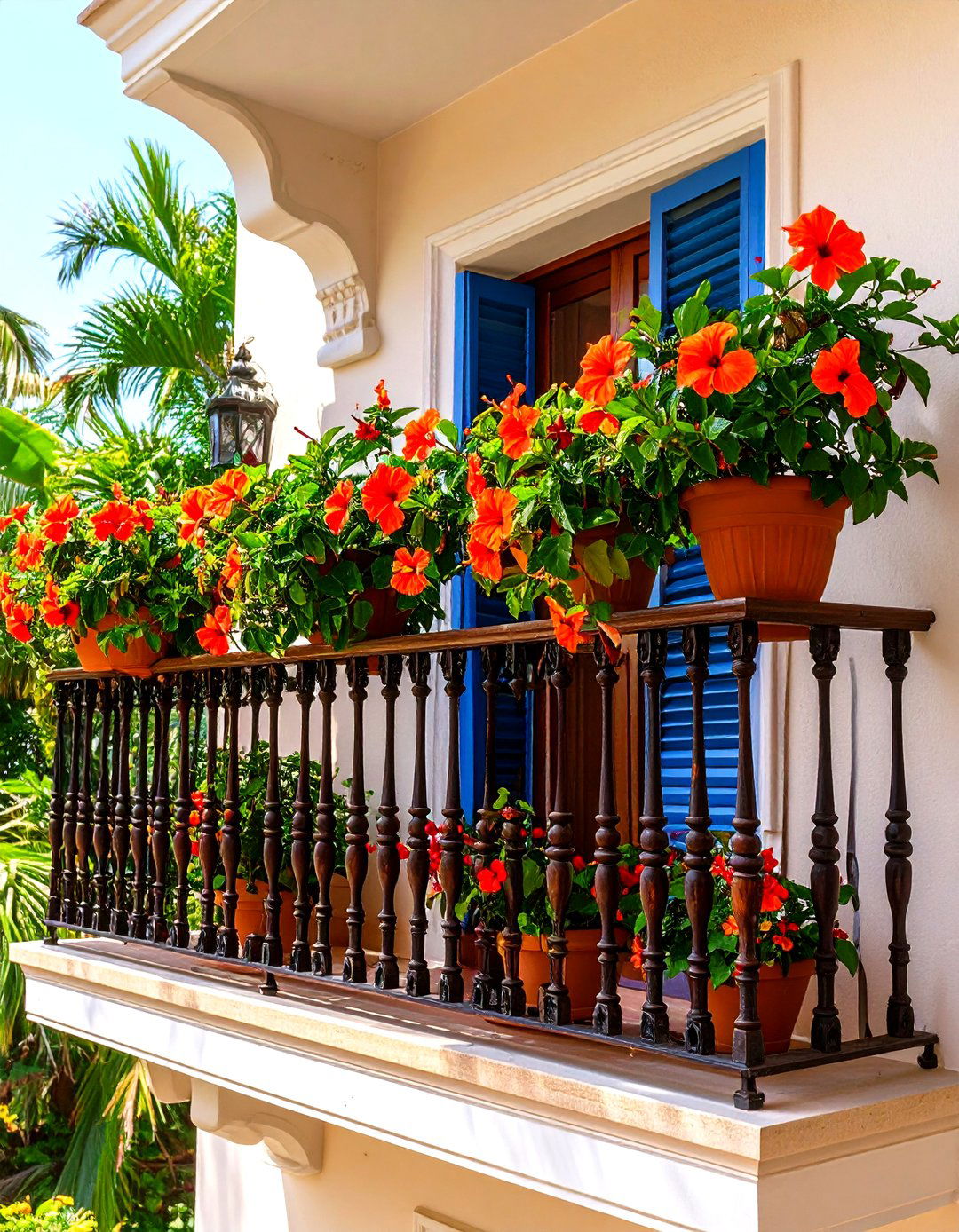
Nothing says “holiday at home” like saucer-sized hibiscus blooms swaying above glossy foliage. Dwarf patio hybrids reach 90 cm but deliver dinner-plate flowers in fiery reds, sunset oranges, and candy pinks. They relish at least six hours of direct light, slightly acidic, free-draining soil, and consistent moisture. Mulch the soil surface with coco coir to slow evaporation on windy balconies, and feed every fortnight with a balanced liquid fertilizer. Remove faded blooms daily to keep new buds forming, and wheel pots indoors if winter dips below 7 °C to preserve the trunk for next season’s tropical encore.
17. Tropical Mandevilla Balcony Vines
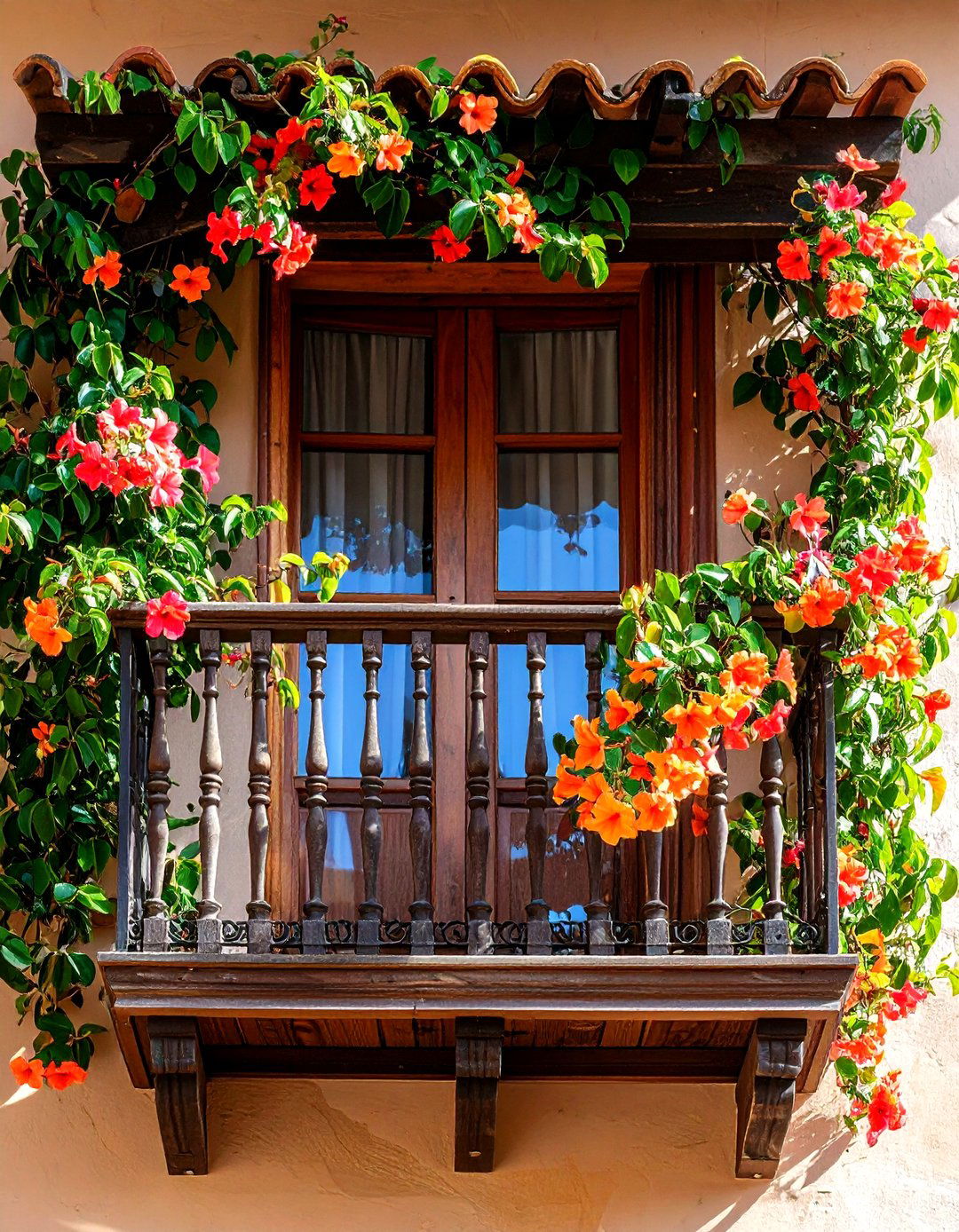
With trumpet flowers and glossy leaves, mandevilla turns a simple trellis into a balcony focal point. Vining types climb two meters; compact strains mound neatly for small patios. Provide a roomy pot with drain holes, sandy rich mix, and at least six hours of sun for peak bloom. Water deeply, allow the surface to dry, and fertilize every two weeks with high-phosphorus food. In cold regions, cut stems by half and overwinter indoors under bright light. Pair with hibiscus or caladiums for an instant tropical tableau that feels miles from the city bustle.
18. Aromatic Lavender Balcony Ease

Few flowering plants repay minimal care with such multisensory rewards as lavender. Its silvery leaves reflect heat, so terracotta pots on scorched ledges become no problem provided drainage is sharp. Six or more hours of sun, infrequent deep watering, and spring pruning of one-third the stem length keep plants compact and floriferous. Harvest spikes just as the lowest florets open for the strongest scent, and dry them upside down indoors for sachets or teas. Even after bloom, neat mounds of foliage provide year-round structure and a calming, Provence-style aroma each time you brush past.
19. Star Jasmine Balcony Screen
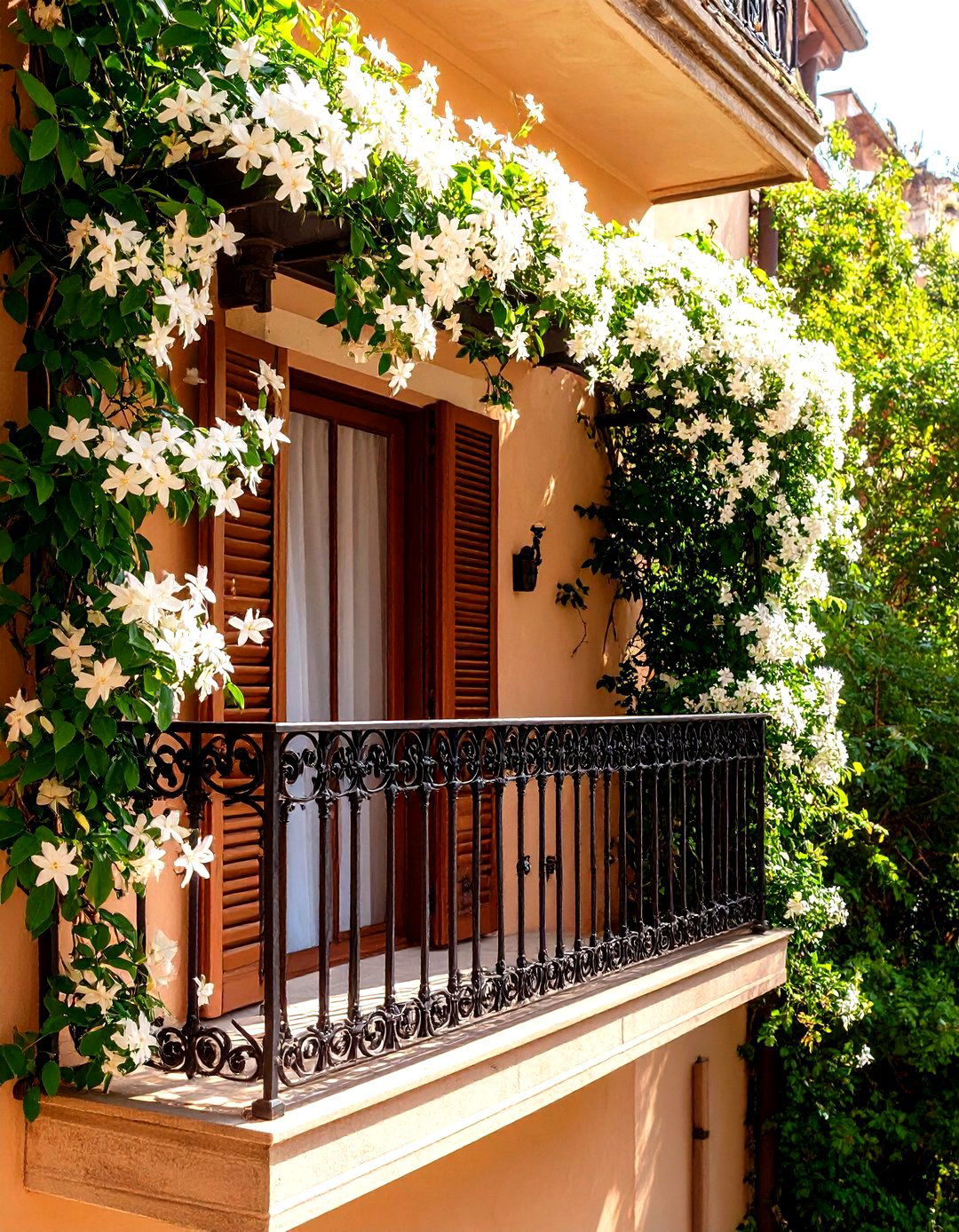
If your balcony doubles as a privacy zone, star jasmine’s twining stems and leathery evergreen leaves form a scented screen in one season. Train vines onto a lightweight trellis, and situate in full to part sun: too much shade cuts bloom, while all-day sun can scorch leaves in extreme heat. Provide acidic potting mix, keep moisture even, and feed monthly during active growth. In early summer, clouds of pinwheel white flowers fill the air with sweet perfume that carries even on gentle breezes, masking city traffic and elevating evening relaxation.
20. Compact Clematis Balcony Climbers
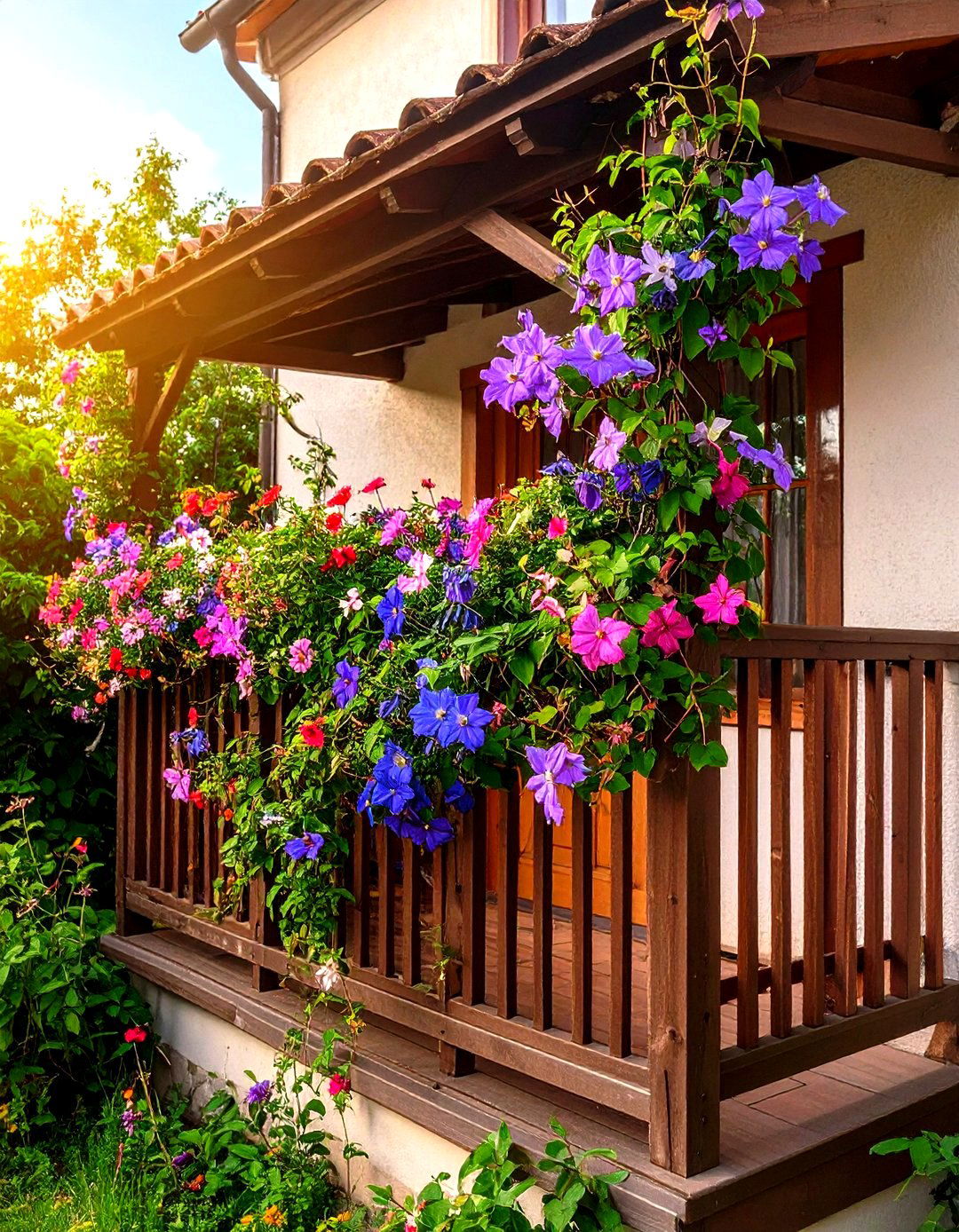
Modern dwarf clematis varieties put the famous “queen of climbers” within container reach. Select a heavy pot with ample drainage, fill with loam-based compost, and keep roots cool by shading the pot sides with mulch or a trailing plant. Water thoroughly, yet avoid winter sogginess. Tie new shoots to a slender lattice, and prune lightly after the first flush to encourage repeat bloom. From deep indigo bells to candy-striped stars, these compact beauties cover a small support without overwhelming railings, delivering a cottage-garden feel five stories up.
Conclusion:
Balcony gardening is a game of smart choices rather than square meters, and each flowering plant above proves you can achieve spectacular color, fragrance, and even edible rewards in containers the size of a shoebox. By matching sun exposure, soil mix, and watering rhythm to a plant’s natural preferences, you create a resilient micro-ecosystem that blooms for months and welcomes pollinators into the sky. Whether you favor the spicy bite of nasturtium, the tropical flair of hibiscus, or the twilight scent of star jasmine, pick a few, adjust care as advised, and watch your balcony transform into an uplifting outdoor room bursting with life.



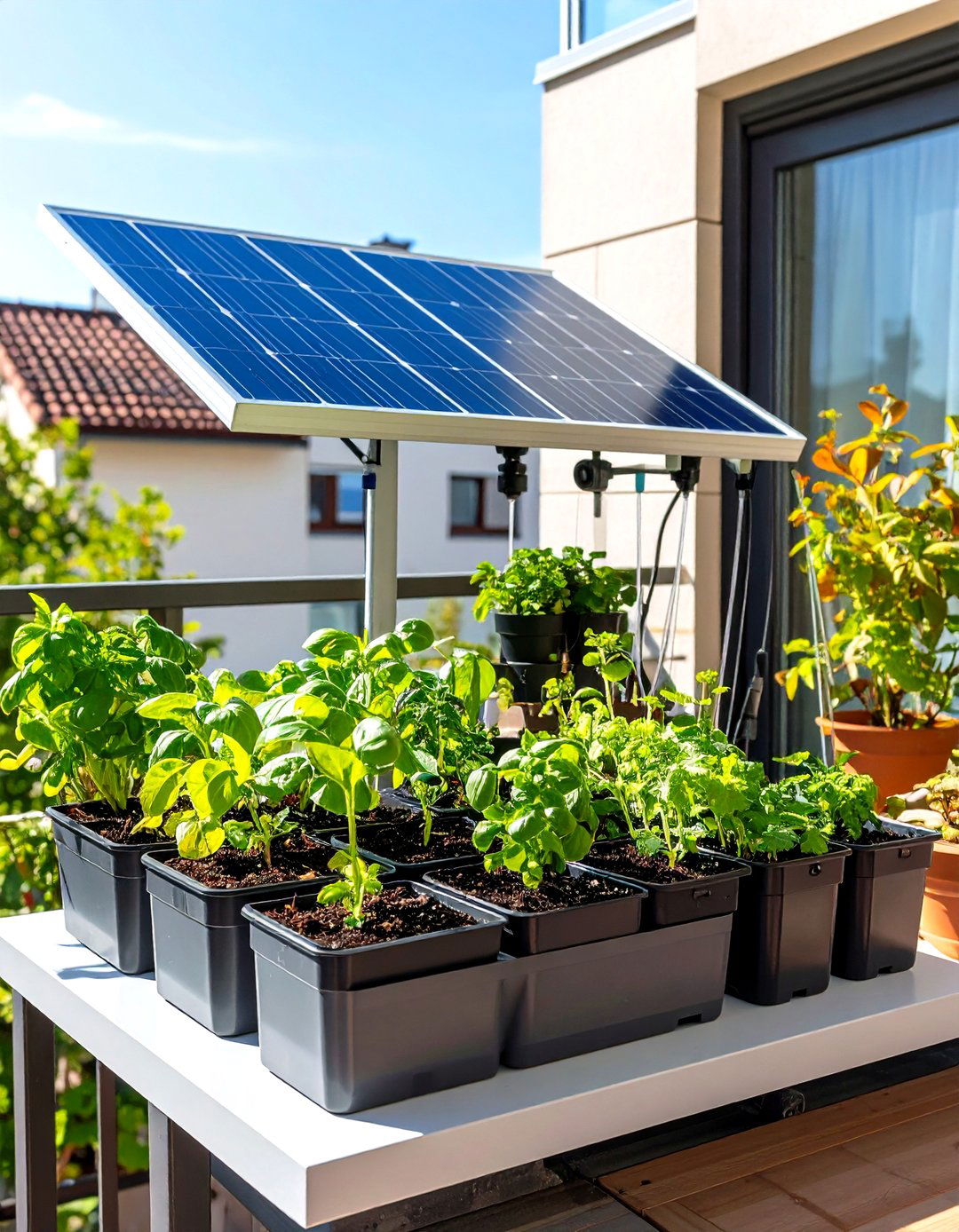

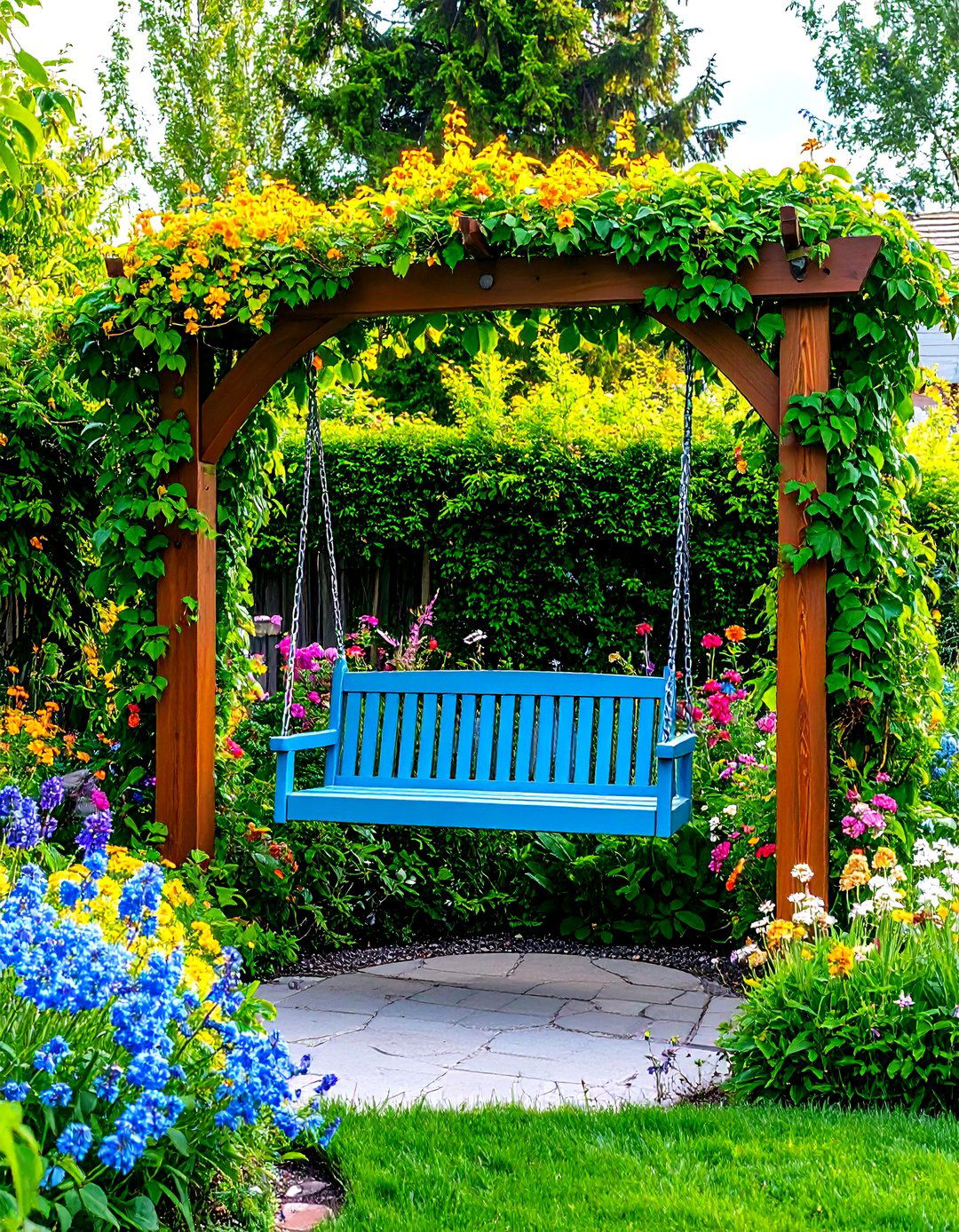
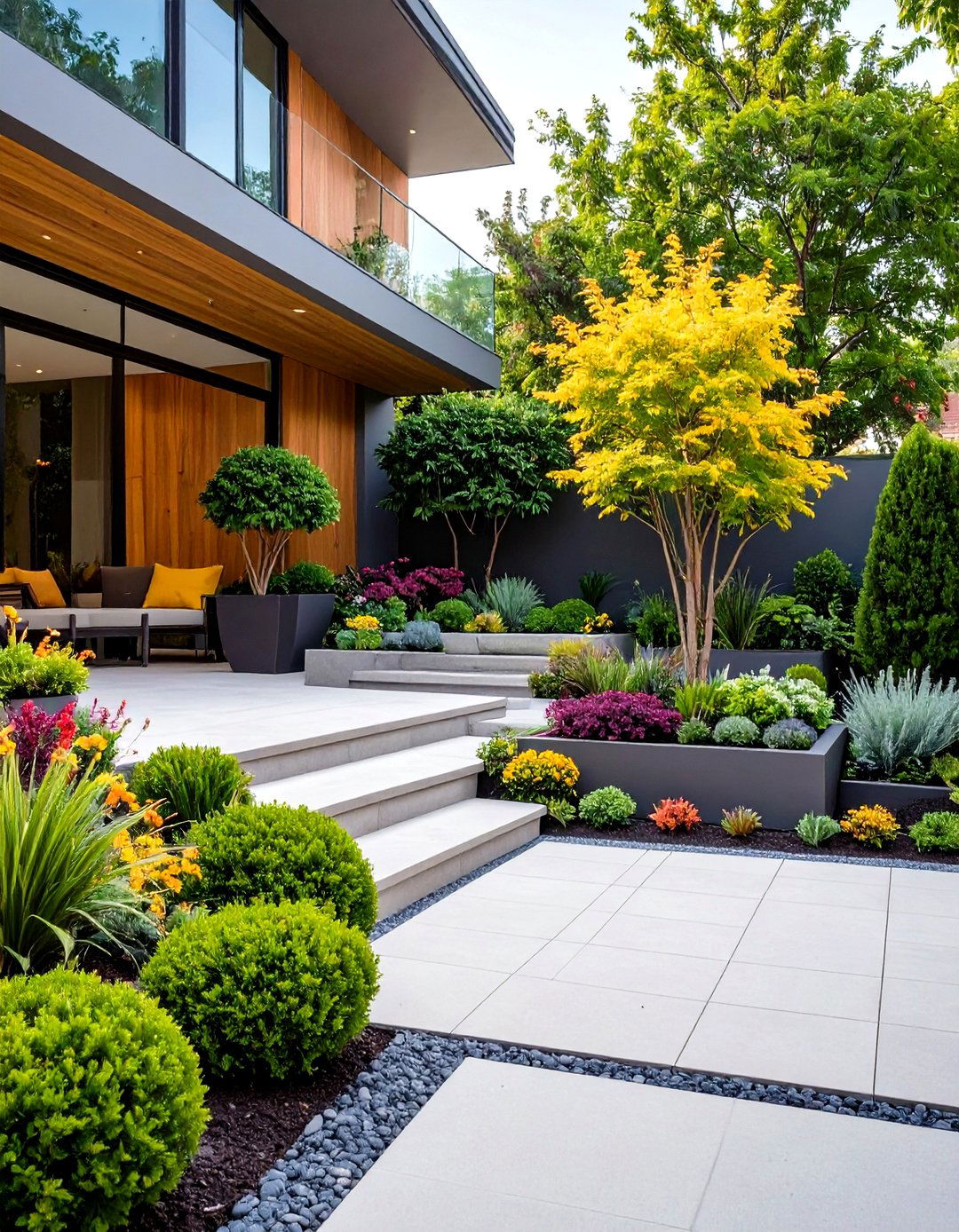

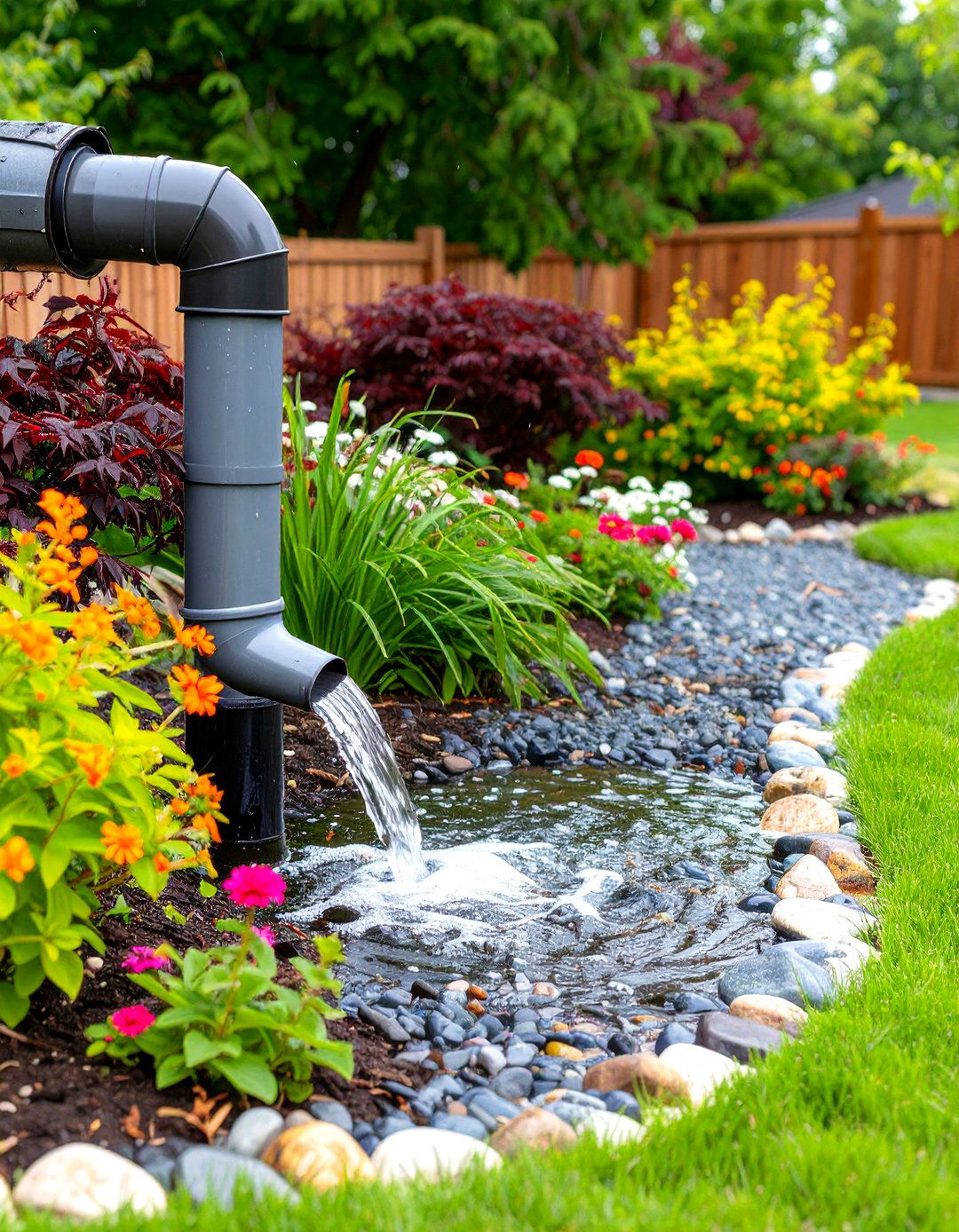
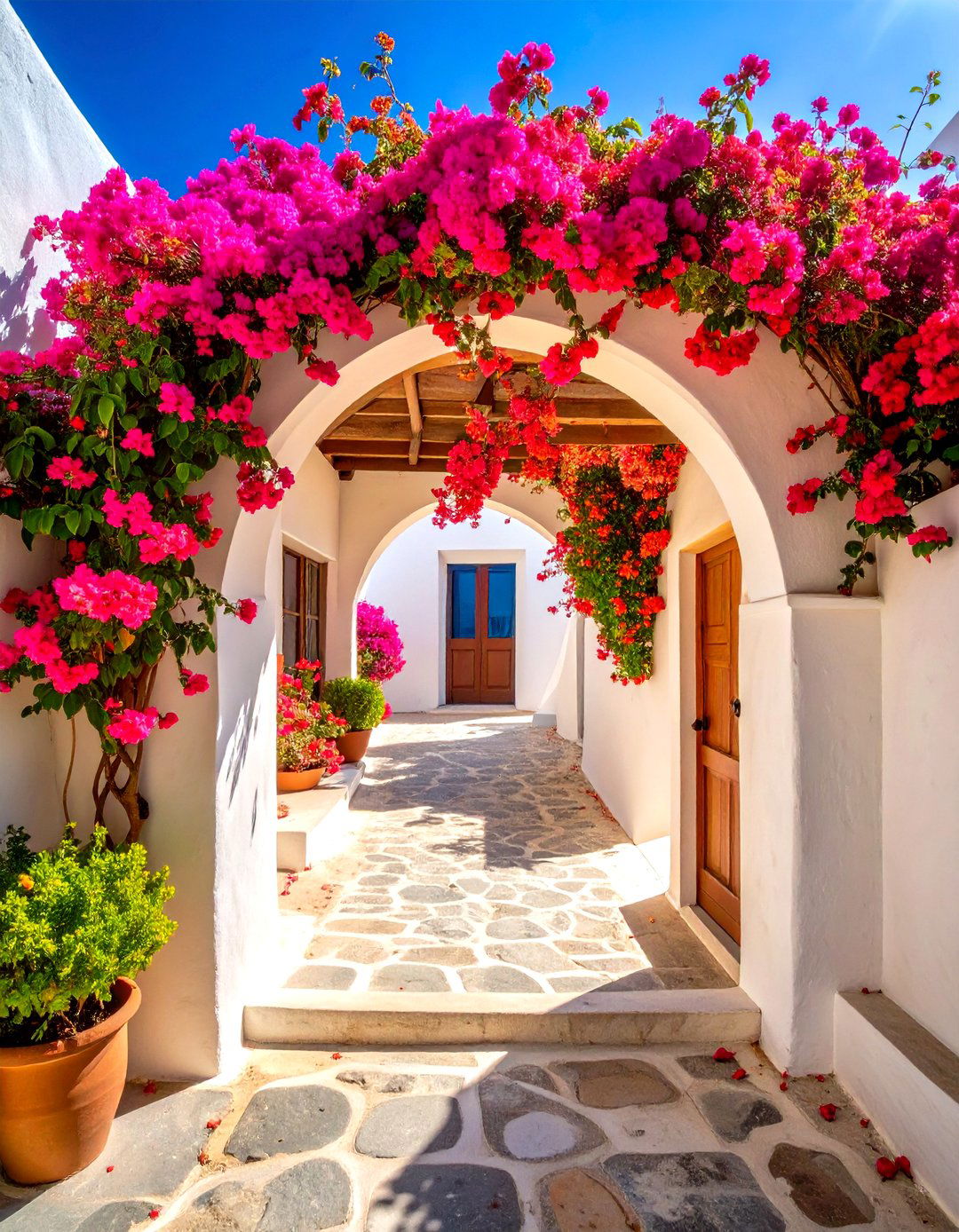
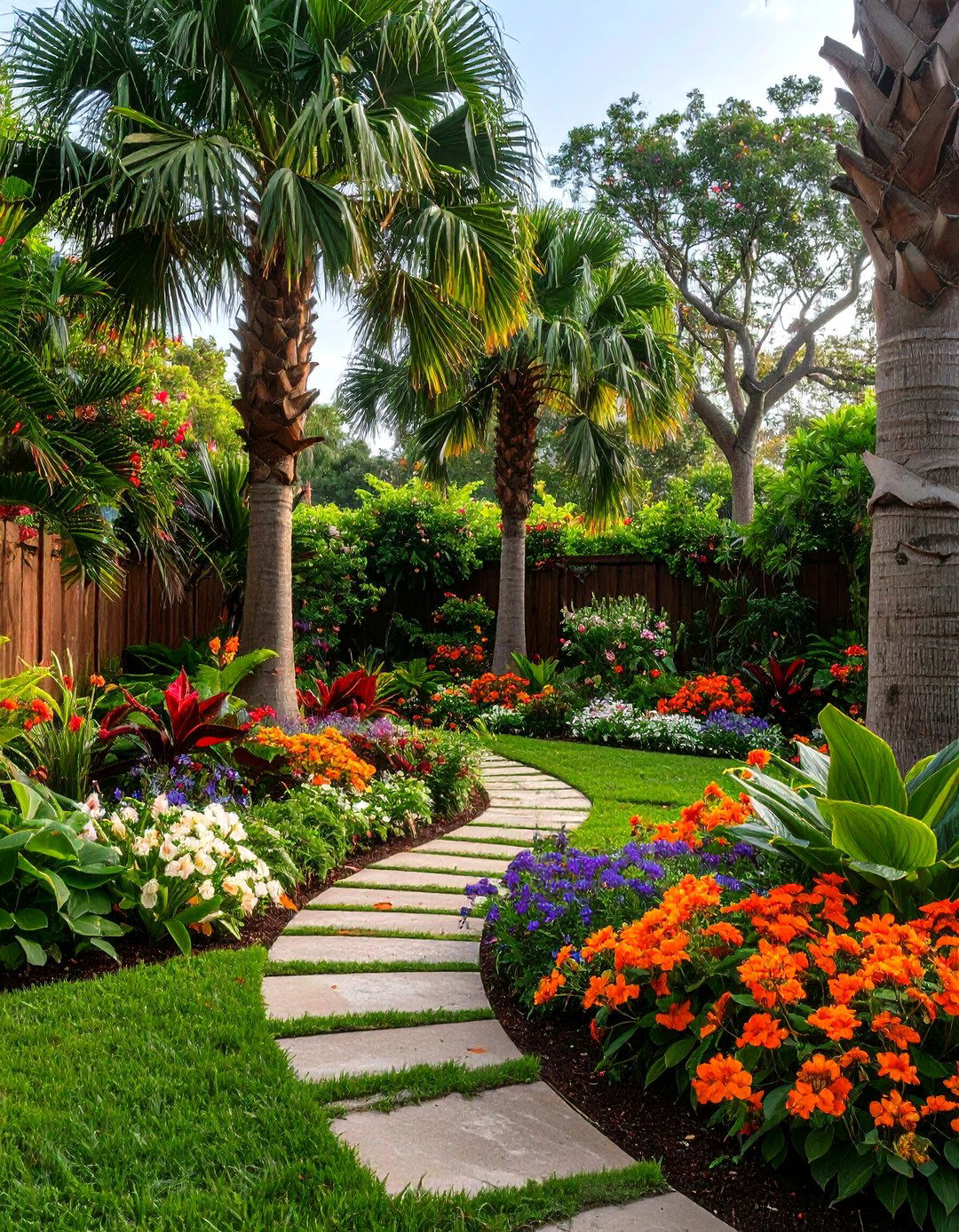




Leave a Reply